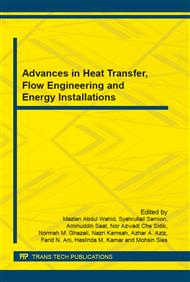p.78
p.83
p.88
p.94
p.101
p.107
p.111
p.117
p.122
Transient Analysis of Microchannel Heat Sink during Single Phase and Flow Boiling Conditions
Abstract:
In the present work, an experimental investigation has been made to analyze the performance of microchannel heat sink under transient operating conditions. The transient analysis has been made by estimating the response time for different input heat flux and coolant mass flow rate. Analysis has been made for rectangular cross-section microchannels fabricated on a copper block of size 25.7 × 12 × 10 mm3. Twelve (12) numbers of microchannels are fabricated in the copper block. The width and depth of individual channels are 400 μm and 750 μm respectively. Performance analysis has been made for both single phase and flow boiling conditions of the coolant flow using deionized water as coolant. Experiments have been performed for coolant mass flux (G) range of 90 - 250 kg/m2s and input heat flux (q) range of 20 - 300 kW/m2 respectively. It has been observed that at constant input heat flux, response time decreases with the increase in coolant mass flux during single phase cooling. However this trend is not strongly followed during the two-phase or flow boiling cooling condition.
Info:
Periodical:
Pages:
101-106
Citation:
Online since:
January 2016
Authors:
Keywords:
Price:
Сopyright:
© 2016 Trans Tech Publications Ltd. All Rights Reserved
Share:
Citation:


